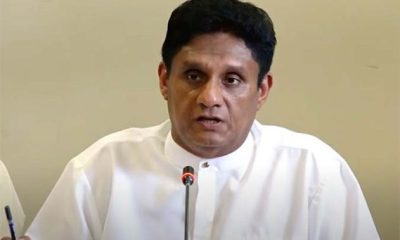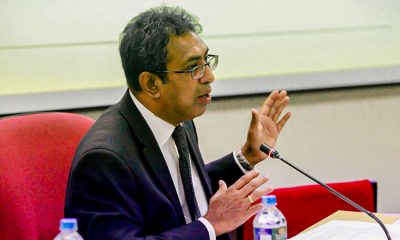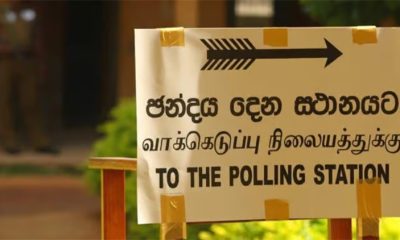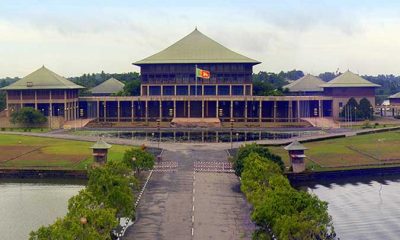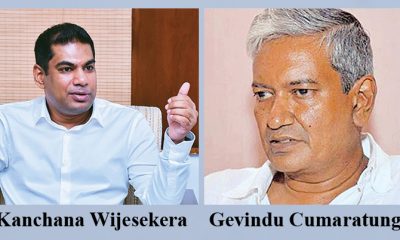Features
Legislative reforms in Ceylon under the British up-to-date
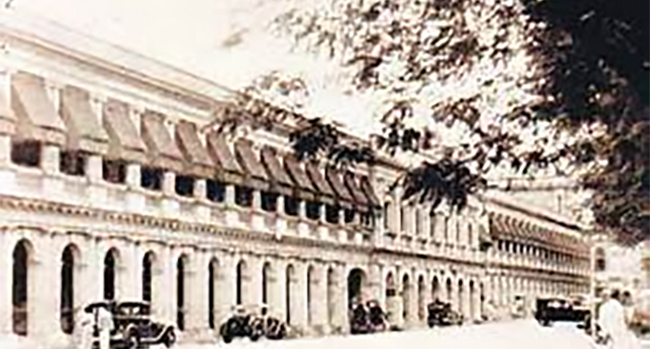
By Nihal Seneviratne
It is widely accepted by all that the early beginnings of legislative reforms in Ceylon started with the arrival of the Colebrook and Cameron Commission in 1833. The commission named after its two prominent members, Johnston Colebrook and Charles Hay Cameron, played a pivotal role in shaping the future of the island.
This commission was established by the British colonial office with the aim of comprehensively studying and reforming various aspects of Ceylon society. One of the key areas of focus for the commission was the legal system of Ceylon. The commission recommended the establishment of a unified legal system based on the English common law which became the foundation for the modern legal system in Ceylon.
It also recommended the establishment of English medium schools which laid the groundwork for the introduction of Western education. In 1835 was established the Colombo Academy which in later years turned out to be Royal College founded by the Governor Horton.
However it is important to acknowledge that the commission recommendations were not without controversy. Some argued that the reforms favoured the interests of the British colonial administration and the emerging local elite while neglecting the rights and aspirations of the major population.
While the commission’s work has been the subject of debate and critique, it serves as a reminder of the complex dynamics between colonial powers and the societies they governed. It was over a long period that the British wanted to gradually handover power to the people. They were entirely conscious of the Sinhala and Tamil elite who did much for British interests and the rulers wanted to adjust the order of things to partly meet their demands.
Thus was established our Executive and Legislative Councils – the two cornerstones along with the Governor and the Colonial Secretary. The Executive Council comprised of six plus the governor and the Legislative Council consisted of all six members of the Executive Council plus four other members (the GA of the Western Province, the Surveyor General, the Principal Collector of Customs and the Attorney General). The unofficial members comprised Sinhalese, Tamils and Burghers. The European community was also represented.
Some of the Sinhalese representatives were Philip Panditaratne, J G Dias, E J Dedigama, James d’ Alwis, J P Obeysekere, William Ellawala and S W Wanninayake. The Tamil representatives were A Coomaraswamy Pulle, Simon Casie Chetty, Muttu Coomaraswamy, Ponnambalam Coomaraswamy, Ponnambalam Ramanathan, Dr W G Rockwood and A Kanagasabey. The Burgher representatives were R J Morgan, C A Lorensz, C A Ferdinando, J Vanculenberg, P D Anthonisz, A L Wendt, and J C Loos.
The functioning of these two councils were found to be ineffectual as there was a need to grant more power to the people. It was then that the Secretary of State for the Colonies appointed the Donoughmore Commission.
Dr Drummond Shields, Francis Butler and Lord Donoughmore arrived in Ceylon in 1927. They recommended universal suffrage for all men and women over 18-yers to be entitled to vote which was indeed a rare move for the countries in South East Asia. They recommended that the two Councils be replaced by a State Council. There were two State Councils elected – one from 1931 to 1936 and the other from 1936 to 1939.
The first State council was composed of 28 low country Sinhalese, 10 Kandyan Sinhalese, three Ceylon Tamils, two Indian Tamils, two Europeans and two Muslims.The second State Council comprised 31 low country Sinhalese, eight Kandyan Sinhalese, eight Ceylon Tamils, two Indian Tamils and one European.
The State Council had increased powers and could make laws on specific subjects – the State Council had a board of ministers which acted as the executive body. The board was responsible for the day-to-day administration of the country and the board had a minister for each subject and was appraised by the Governor.
The functioning of the two State Councils was found to be wavering and mediocre. So the British government appointed the Soulbury Commission to visit Ceylon and grant wider powers.
The Soulbury Commission comprised of (first Baron later Viscount Soulbury, J F Rees and S J Burrows. The British government, just after World War II was not quite ready to prepare a new constitution for Ceylon. The colonial office was not ready at all and they consulted Prime Minister D S Senanayake about drafting new legislation in Ceylon itself. The legal draftsmen at that time were two Britishers, Drayton and Nevill.
So the task of drafting a new constitution was passed on to the draftsmen, like Namasivayam Mahadeva and B P Pieris, who undertook the work. Sir Ivor Jennings was in Ceylon at the time and had prepared a draft – there was also the report of the Soulbury Commission, a whole paper embodying the demands of the UK government.
B P Pieris’ draft was finally approved by Drayton and Nevill and was submitted to D S Senanayake, the PM. It was widely believed that the Prime Minister had told B P Pieris that he would be hanged by his neck if there was any leak of the draft and moreover the CID had been put on the job to have surveillance over the drafts as it was considered a top secret.
The Soulbury Commission recommended a parliament of two houses- a House of Representatives and a Senate. The House of Representatives comprised a total of 101 MPs consisting of 95 elected members and six others nominated by the Governor General, on the advice of the PM. The Senate (ultimately abolished in 1971) was to comprise 30 members, 15 elected by the House and 15 appointed by the Governor General. The Ceylon Constitution Order-in-Council was approved by His Majesty the King and was gazetted.
The Soulbury Commission had two very important sections included in the new constitution- S 29 (2) which prevented any bill, motion or resolution being entertained in parliament which meant that no special advantage be conceded to any racial or religious group. The other section was re the appointment of a Public Service Commission. Under this no minister could appoint any public servant or transfer or take any disciplinary action against a public servant as the sole power was with the Public Service Commission.
Very sadly the PSC did not have these powers in the subsequent 1972 republican constitution. The standing orders of parliament were drafted by B P Pieris together with the help of Sir Edward Fellowes, clerk to the British House of Commons and by Ralph Deraniyagala the clerk of the House of Representatives.
The new government was established with the promulgation of the new constitution. The new Governor General Henry Monk-Mason Moore called on D S Senanayake to form a cabinet. This first cabinet of Ceylon comprised of 14 – namely J R Jayewardene, L A Rajapakse, S W R D Bandaranaike, Sir Oliver Goonetilleke, George E de Silva, Sir John Kotalawela, Dudley Senanayake, R S S Gunawardene, C. Suntheralingam, T B Jayah, E A Nugawela, A Ratnayake and C Sittampalam.
The very first meeting was held on October 8, 1947. Order-in-Council to remove limitations of self-government in the Ceylon constitution was passed. The following motion was passed in Parliament:
“This House rejoices that after many years of subjugation to foreign rule the struggle of the people of Ceylon for freedom has culminated in the attainment of Independence.” The First Parliament was opened by the Duke of Gloucester.
Birth of the 1972 Constitution: Mrs Sirimavo Bandaranaike was appointed Prime Minister in 1972 and appointed Dr Colvin R de Silva as Minister of Constitutional Affairs. Mrs Bandaranaike moved a resolution in the House in July 1970 that all 225 Members of the House be appointed Members of the Constitutional Assembly to draft a new constitution for Sri Lanka replacing the Soulbury Constitution.
Dr Colvin R de Silva was of the opinion that the Soulbury Constitution was established by the British Government and felt that a Sri Lanka-made constitution should replace it, severing all connections with the Soulbury Commission. It was decided that that all 225 MPs be a part of the Constituent Assembly and decided that they should meet at Navarangahala at the Royal Primary School.
This Constituent Assembly sat on 49 occasions from July 19, 1970 to May 22, 1972 at the Navarangahala Hall and deliberated. Dr de Silva chose Walter Jayawardene, a Barrister from the UK and close friend of his to be Secretary to the Constituent Assembly and Mr Sam Wijesinha and myself were appointed as Asst. Secretaries.
The shift towards a republican constitution was driven by the desire to establish a more independent and sovereign nation, free from the vestiges of colonial influence. One of the key features of the republican constitution was changing the name of the country from Ceylon to the Republic of Sri Lanka and making the last serving Governor-General of Ceylon, Mr. William Gopallawa as the first (Non-executive) President of the Republic. The new constitution symbolized the growing determination for the country to assert its own identity and self governance.
The Republican Constitution emphasized the concept of sovereignty and the unity of Sri Lanka as a multi-ethnic and multi-religious nation. It recognized Sinhalese as the official language promoting the cultural heritage of the majority Sinhala population. However this decision also created tensions and grievances among the Tamil-speaking minority communities leading to political and social unrest in the years to come.
Furthermore the republican constitution introduced a a unicameral legislature called the National State Assembly replaced by the previous bicameral system. The Prime Minister along with the cabinet became the executive body responsible for governing the country and implementing policies.
It is important to write that the 1972 Republican Constitution was not without its controversies and errors. Many argued that it marginalized minority communities and failed to address adequately their concerns. This laid the groundwork for subsequent constitutional reforms. This republican constitution was a significant turning point in the country’s constitutional history.
In 1977 J R Jayewardene came to power with a 5/6 majority. Soon after in October 29,, 1977 the leader of the House moved that a select committee be set up to consider a revision of the constitution.
On November 3, 1977 the Speaker made the announcement that J R Jayewardene be appointed as Chairman of the select committee and that Mr R Premadasa, Lalith Athulathmudali, Mr Ronnie de Mel, Mr Gamini Disanayake, Mr K W Dewanayagam, Mr M H M Naina Marikkar, Mr S Thondaman, Ms Sirimavo Bandaranaike and Mr Maithripala Senanayake be its members.
The committee sat for 14 days from January to June 1978. On August 10, 1978 the new constitution was adopted in the House. For the very first time we saw the departure from the Westminster system and the introduction of presidential system. Much has been written about its pros and cons and a controversy survives to this day.
A final, personal comment. It was President J R Jayewardene’s last day in parliament (before he became executive president). In the lobby of the parliament I went up to him and said “Sir you have a log history in this House and we are all sorry to not see you here any more.”
He replied: “Nihal, I want to see parliament from a distance and make up my mind. I will be in touch with parliament”, and left for the last time.
The writer is a retired Secretary General of the Sri Lanka Parliament.
Features
The heart-friendly health minister

by Dr Gotabhya Ranasinghe
Senior Consultant Cardiologist
National Hospital Sri Lanka
When we sought a meeting with Hon Dr. Ramesh Pathirana, Minister of Health, he graciously cleared his busy schedule to accommodate us. Renowned for his attentive listening and deep understanding, Minister Pathirana is dedicated to advancing the health sector. His openness and transparency exemplify the qualities of an exemplary politician and minister.
Dr. Palitha Mahipala, the current Health Secretary, demonstrates both commendable enthusiasm and unwavering support. This combination of attributes makes him a highly compatible colleague for the esteemed Minister of Health.
Our discussion centered on a project that has been in the works for the past 30 years, one that no other minister had managed to advance.
Minister Pathirana, however, recognized the project’s significance and its potential to revolutionize care for heart patients.
The project involves the construction of a state-of-the-art facility at the premises of the National Hospital Colombo. The project’s location within the premises of the National Hospital underscores its importance and relevance to the healthcare infrastructure of the nation.
This facility will include a cardiology building and a tertiary care center, equipped with the latest technology to handle and treat all types of heart-related conditions and surgeries.
Securing funding was a major milestone for this initiative. Minister Pathirana successfully obtained approval for a $40 billion loan from the Asian Development Bank. With the funding in place, the foundation stone is scheduled to be laid in September this year, and construction will begin in January 2025.
This project guarantees a consistent and uninterrupted supply of stents and related medications for heart patients. As a result, patients will have timely access to essential medical supplies during their treatment and recovery. By securing these critical resources, the project aims to enhance patient outcomes, minimize treatment delays, and maintain the highest standards of cardiac care.
Upon its fruition, this monumental building will serve as a beacon of hope and healing, symbolizing the unwavering dedication to improving patient outcomes and fostering a healthier society.We anticipate a future marked by significant progress and positive outcomes in Sri Lanka’s cardiovascular treatment landscape within the foreseeable timeframe.
Features
A LOVING TRIBUTE TO JESUIT FR. ALOYSIUS PIERIS ON HIS 90th BIRTHDAY

by Fr. Emmanuel Fernando, OMI
Jesuit Fr. Aloysius Pieris (affectionately called Fr. Aloy) celebrated his 90th birthday on April 9, 2024 and I, as the editor of our Oblate Journal, THE MISSIONARY OBLATE had gone to press by that time. Immediately I decided to publish an article, appreciating the untiring selfless services he continues to offer for inter-Faith dialogue, the renewal of the Catholic Church, his concern for the poor and the suffering Sri Lankan masses and to me, the present writer.
It was in 1988, when I was appointed Director of the Oblate Scholastics at Ampitiya by the then Oblate Provincial Fr. Anselm Silva, that I came to know Fr. Aloy more closely. Knowing well his expertise in matters spiritual, theological, Indological and pastoral, and with the collaborative spirit of my companion-formators, our Oblate Scholastics were sent to Tulana, the Research and Encounter Centre, Kelaniya, of which he is the Founder-Director, for ‘exposure-programmes’ on matters spiritual, biblical, theological and pastoral. Some of these dimensions according to my view and that of my companion-formators, were not available at the National Seminary, Ampitiya.
Ever since that time, our Oblate formators/ accompaniers at the Oblate Scholasticate, Ampitiya , have continued to send our Oblate Scholastics to Tulana Centre for deepening their insights and convictions regarding matters needed to serve the people in today’s context. Fr. Aloy also had tried very enthusiastically with the Oblate team headed by Frs. Oswald Firth and Clement Waidyasekara to begin a Theologate, directed by the Religious Congregations in Sri Lanka, for the contextual formation/ accompaniment of their members. It should very well be a desired goal of the Leaders / Provincials of the Religious Congregations.
Besides being a formator/accompanier at the Oblate Scholasticate, I was entrusted also with the task of editing and publishing our Oblate journal, ‘The Missionary Oblate’. To maintain the quality of the journal I continue to depend on Fr. Aloy for his thought-provoking and stimulating articles on Biblical Spirituality, Biblical Theology and Ecclesiology. I am very grateful to him for his generous assistance. Of late, his writings on renewal of the Church, initiated by Pope St. John XX111 and continued by Pope Francis through the Synodal path, published in our Oblate journal, enable our readers to focus their attention also on the needed renewal in the Catholic Church in Sri Lanka. Fr. Aloy appreciated very much the Synodal path adopted by the Jesuit Pope Francis for the renewal of the Church, rooted very much on prayerful discernment. In my Religious and presbyteral life, Fr.Aloy continues to be my spiritual animator / guide and ongoing formator / acccompanier.
Fr. Aloysius Pieris, BA Hons (Lond), LPh (SHC, India), STL (PFT, Naples), PhD (SLU/VC), ThD (Tilburg), D.Ltt (KU), has been one of the eminent Asian theologians well recognized internationally and one who has lectured and held visiting chairs in many universities both in the West and in the East. Many members of Religious Congregations from Asian countries have benefited from his lectures and guidance in the East Asian Pastoral Institute (EAPI) in Manila, Philippines. He had been a Theologian consulted by the Federation of Asian Bishops’ Conferences for many years. During his professorship at the Gregorian University in Rome, he was called to be a member of a special group of advisers on other religions consulted by Pope Paul VI.
Fr. Aloy is the author of more than 30 books and well over 500 Research Papers. Some of his books and articles have been translated and published in several countries. Among those books, one can find the following: 1) The Genesis of an Asian Theology of Liberation (An Autobiographical Excursus on the Art of Theologising in Asia, 2) An Asian Theology of Liberation, 3) Providential Timeliness of Vatican 11 (a long-overdue halt to a scandalous millennium, 4) Give Vatican 11 a chance, 5) Leadership in the Church, 6) Relishing our faith in working for justice (Themes for study and discussion), 7) A Message meant mainly, not exclusively for Jesuits (Background information necessary for helping Francis renew the Church), 8) Lent in Lanka (Reflections and Resolutions, 9) Love meets wisdom (A Christian Experience of Buddhism, 10) Fire and Water 11) God’s Reign for God’s poor, 12) Our Unhiddden Agenda (How we Jesuits work, pray and form our men). He is also the Editor of two journals, Vagdevi, Journal of Religious Reflection and Dialogue, New Series.
Fr. Aloy has a BA in Pali and Sanskrit from the University of London and a Ph.D in Buddhist Philosophy from the University of Sri Lankan, Vidyodaya Campus. On Nov. 23, 2019, he was awarded the prestigious honorary Doctorate of Literature (D.Litt) by the Chancellor of the University of Kelaniya, the Most Venerable Welamitiyawe Dharmakirthi Sri Kusala Dhamma Thera.
Fr. Aloy continues to be a promoter of Gospel values and virtues. Justice as a constitutive dimension of love and social concern for the downtrodden masses are very much noted in his life and work. He had very much appreciated the commitment of the late Fr. Joseph (Joe) Fernando, the National Director of the Social and Economic Centre (SEDEC) for the poor.
In Sri Lanka, a few religious Congregations – the Good Shepherd Sisters, the Christian Brothers, the Marist Brothers and the Oblates – have invited him to animate their members especially during their Provincial Congresses, Chapters and International Conferences. The mainline Christian Churches also have sought his advice and followed his seminars. I, for one, regret very much, that the Sri Lankan authorities of the Catholic Church –today’s Hierarchy—- have not sought Fr.
Aloy’s expertise for the renewal of the Catholic Church in Sri Lanka and thus have not benefited from the immense store of wisdom and insight that he can offer to our local Church while the Sri Lankan bishops who governed the Catholic church in the immediate aftermath of the Second Vatican Council (Edmund Fernando OMI, Anthony de Saram, Leo Nanayakkara OSB, Frank Marcus Fernando, Paul Perera,) visited him and consulted him on many matters. Among the Tamil Bishops, Bishop Rayappu Joseph was keeping close contact with him and Bishop J. Deogupillai hosted him and his team visiting him after the horrible Black July massacre of Tamils.
Features
A fairy tale, success or debacle

Sri Lanka-Singapore Free Trade Agreement
By Gomi Senadhira
senadhiragomi@gmail.com
“You might tell fairy tales, but the progress of a country cannot be achieved through such narratives. A country cannot be developed by making false promises. The country moved backward because of the electoral promises made by political parties throughout time. We have witnessed that the ultimate result of this is the country becoming bankrupt. Unfortunately, many segments of the population have not come to realize this yet.” – President Ranil Wickremesinghe, 2024 Budget speech
Any Sri Lankan would agree with the above words of President Wickremesinghe on the false promises our politicians and officials make and the fairy tales they narrate which bankrupted this country. So, to understand this, let’s look at one such fairy tale with lots of false promises; Ranil Wickremesinghe’s greatest achievement in the area of international trade and investment promotion during the Yahapalana period, Sri Lanka-Singapore Free Trade Agreement (SLSFTA).
It is appropriate and timely to do it now as Finance Minister Wickremesinghe has just presented to parliament a bill on the National Policy on Economic Transformation which includes the establishment of an Office for International Trade and the Sri Lanka Institute of Economics and International Trade.
Was SLSFTA a “Cleverly negotiated Free Trade Agreement” as stated by the (former) Minister of Development Strategies and International Trade Malik Samarawickrama during the Parliamentary Debate on the SLSFTA in July 2018, or a colossal blunder covered up with lies, false promises, and fairy tales? After SLSFTA was signed there were a number of fairy tales published on this agreement by the Ministry of Development Strategies and International, Institute of Policy Studies, and others.
However, for this article, I would like to limit my comments to the speech by Minister Samarawickrama during the Parliamentary Debate, and the two most important areas in the agreement which were covered up with lies, fairy tales, and false promises, namely: revenue loss for Sri Lanka and Investment from Singapore. On the other important area, “Waste products dumping” I do not want to comment here as I have written extensively on the issue.
1. The revenue loss
During the Parliamentary Debate in July 2018, Minister Samarawickrama stated “…. let me reiterate that this FTA with Singapore has been very cleverly negotiated by us…. The liberalisation programme under this FTA has been carefully designed to have the least impact on domestic industry and revenue collection. We have included all revenue sensitive items in the negative list of items which will not be subject to removal of tariff. Therefore, 97.8% revenue from Customs duty is protected. Our tariff liberalisation will take place over a period of 12-15 years! In fact, the revenue earned through tariffs on goods imported from Singapore last year was Rs. 35 billion.
The revenue loss for over the next 15 years due to the FTA is only Rs. 733 million– which when annualised, on average, is just Rs. 51 million. That is just 0.14% per year! So anyone who claims the Singapore FTA causes revenue loss to the Government cannot do basic arithmetic! Mr. Speaker, in conclusion, I call on my fellow members of this House – don’t mislead the public with baseless criticism that is not grounded in facts. Don’t look at petty politics and use these issues for your own political survival.”
I was surprised to read the minister’s speech because an article published in January 2018 in “The Straits Times“, based on information released by the Singaporean Negotiators stated, “…. With the FTA, tariff savings for Singapore exports are estimated to hit $10 million annually“.
As the annual tariff savings (that is the revenue loss for Sri Lanka) calculated by the Singaporean Negotiators, Singaporean $ 10 million (Sri Lankan rupees 1,200 million in 2018) was way above the rupees’ 733 million revenue loss for 15 years estimated by the Sri Lankan negotiators, it was clear to any observer that one of the parties to the agreement had not done the basic arithmetic!
Six years later, according to a report published by “The Morning” newspaper, speaking at the Committee on Public Finance (COPF) on 7th May 2024, Mr Samarawickrama’s chief trade negotiator K.J. Weerasinghehad had admitted “…. that forecasted revenue loss for the Government of Sri Lanka through the Singapore FTA is Rs. 450 million in 2023 and Rs. 1.3 billion in 2024.”
If these numbers are correct, as tariff liberalisation under the SLSFTA has just started, we will pass Rs 2 billion very soon. Then, the question is how Sri Lanka’s trade negotiators made such a colossal blunder. Didn’t they do their basic arithmetic? If they didn’t know how to do basic arithmetic they should have at least done their basic readings. For example, the headline of the article published in The Straits Times in January 2018 was “Singapore, Sri Lanka sign FTA, annual savings of $10m expected”.
Anyway, as Sri Lanka’s chief negotiator reiterated at the COPF meeting that “…. since 99% of the tariffs in Singapore have zero rates of duty, Sri Lanka has agreed on 80% tariff liberalisation over a period of 15 years while expecting Singapore investments to address the imbalance in trade,” let’s turn towards investment.
Investment from Singapore
In July 2018, speaking during the Parliamentary Debate on the FTA this is what Minister Malik Samarawickrama stated on investment from Singapore, “Already, thanks to this FTA, in just the past two-and-a-half months since the agreement came into effect we have received a proposal from Singapore for investment amounting to $ 14.8 billion in an oil refinery for export of petroleum products. In addition, we have proposals for a steel manufacturing plant for exports ($ 1 billion investment), flour milling plant ($ 50 million), sugar refinery ($ 200 million). This adds up to more than $ 16.05 billion in the pipeline on these projects alone.
And all of these projects will create thousands of more jobs for our people. In principle approval has already been granted by the BOI and the investors are awaiting the release of land the environmental approvals to commence the project.
I request the Opposition and those with vested interests to change their narrow-minded thinking and join us to develop our country. We must always look at what is best for the whole community, not just the few who may oppose. We owe it to our people to courageously take decisions that will change their lives for the better.”
According to the media report I quoted earlier, speaking at the Committee on Public Finance (COPF) Chief Negotiator Weerasinghe has admitted that Sri Lanka was not happy with overall Singapore investments that have come in the past few years in return for the trade liberalisation under the Singapore-Sri Lanka Free Trade Agreement. He has added that between 2021 and 2023 the total investment from Singapore had been around $162 million!
What happened to those projects worth $16 billion negotiated, thanks to the SLSFTA, in just the two-and-a-half months after the agreement came into effect and approved by the BOI? I do not know about the steel manufacturing plant for exports ($ 1 billion investment), flour milling plant ($ 50 million) and sugar refinery ($ 200 million).
However, story of the multibillion-dollar investment in the Petroleum Refinery unfolded in a manner that would qualify it as the best fairy tale with false promises presented by our politicians and the officials, prior to 2019 elections.
Though many Sri Lankans got to know, through the media which repeatedly highlighted a plethora of issues surrounding the project and the questionable credentials of the Singaporean investor, the construction work on the Mirrijiwela Oil Refinery along with the cement factory began on the24th of March 2019 with a bang and Minister Ranil Wickremesinghe and his ministers along with the foreign and local dignitaries laid the foundation stones.
That was few months before the 2019 Presidential elections. Inaugurating the construction work Prime Minister Ranil Wickremesinghe said the projects will create thousands of job opportunities in the area and surrounding districts.
The oil refinery, which was to be built over 200 acres of land, with the capacity to refine 200,000 barrels of crude oil per day, was to generate US$7 billion of exports and create 1,500 direct and 3,000 indirect jobs. The construction of the refinery was to be completed in 44 months. Four years later, in August 2023 the Cabinet of Ministers approved the proposal presented by President Ranil Wickremesinghe to cancel the agreement with the investors of the refinery as the project has not been implemented! Can they explain to the country how much money was wasted to produce that fairy tale?
It is obvious that the President, ministers, and officials had made huge blunders and had deliberately misled the public and the parliament on the revenue loss and potential investment from SLSFTA with fairy tales and false promises.
As the president himself said, a country cannot be developed by making false promises or with fairy tales and these false promises and fairy tales had bankrupted the country. “Unfortunately, many segments of the population have not come to realize this yet”.
(The writer, a specialist and an activist on trade and development issues . )


